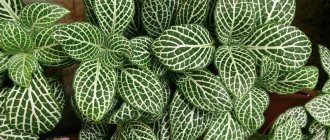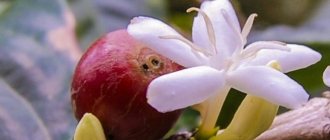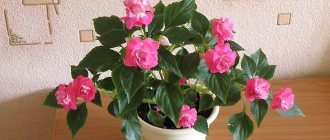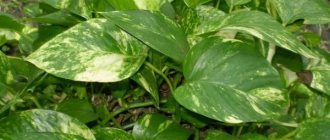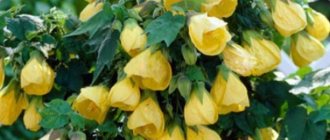Pachyphytum is a beautiful and unusual flower. Its small size looks good in an indoor flower garden or as part of a flower arrangement. This drought-resistant plant requires almost no attention and is easy to care for. Only a few species are bred at home, the most popular of which is Pachyphytum oviferum. It attracts with its unusual colors and compact rosettes.
Briefly about care
| Type of agricultural operation for pachyphytum care | Description of conditions and actions |
| Watering and air humidity | Water only when the soil dries out by a third in summer and almost completely in winter; humidity is dangerous for pachyphytum: rot can develop on the leaves |
| Lighting organization | Lighting prefers bright, but diffused |
| Maintaining a rest period | From early autumn to February - March; you need to reduce the frequency of watering and temperature |
| Creating temperature conditions | During the development period it should be 20-26 °C, and in winter - 12-16 °C; if the temperature drops to – 10 °C, the plant will freeze |
| Trimming | If necessary, to give a neat look |
| Making soil mixture | The soil needs to be loose and depleted in nutrients (it is good to use a mixture of soil for cacti and succulents with sand and perlite) |
| Fertilizer application | Fertilize pachyphytum 3–4 times during the period of active growth; use either potassium-phosphorus fertilizers or fertilizer for succulents and cacti (the dosage should be twice as weak as recommended) |
| Transfer | Pachyphytum needs to be replanted once every 2 years into a slightly larger flat container. |
| Chemical treatment | Insecticides: mealybug; fungicides: rot |
Diseases and pests
The pachyphytum flower is resistant to diseases and is not damaged by insect pests. The only problem can be excessive watering and high air humidity - the flower is susceptible to leaf and root rot.
If rot has already occurred, then it is easier to root cuttings from healthy parts of the plant than to save the damaged one. When replanting, it is imperative to disinfect the pots.
Description of the plant
Pachyphytum oviferum is a perennial plant from the Pachyphytum genus of the Crassulaceae family. In nature, this genus grows in Mexico and the southern states of the USA. All its plants are characterized by thick, fleshy leaves that store water, which is why they got their name.
In the photo, egg-bearing pachyphytum (P. oviferum)
The main difference between the egg-bearing variety is the appearance and color of the leaf. Its shape looks like a bizarre oval or a slightly flattened egg. Also, the top of the leaf blade is rounded, without a clear tip. The crown is gray in color, with a whitish coating on the surface. Because of its color and appearance, the plant was nicknamed “moonstone”.
Reference! There is pachyphytum oviferum rubra (P. oviferum rubra): this variety has almost completely pink leaves, only the stem has a lighter edge.
The plant has a compact appearance: the leaves are quite dense, and the stems themselves are no longer than 20 cm. The underground system consists of thin, highly branched roots.
The leaves are voluminous, they usually reach 1.5–2 cm in thickness, and are large enough for a succulent: up to 5 cm in length and 3 cm in width. They are arranged in a spiral pattern on the stem.
Arrangement of pachyphytum leaves
The shoots are initially erect and then drooping. With age, they stretch out and become bare below: old leaves dry out and fall off, leaving behind a scar on the stem. On top there is a rather dense socket. The stems often branch, forming lateral shoots.
Growing conditions for indoor pachyphytums
For light- and heat-loving pachyphytum, finding a comfortable place in the house is not at all difficult. The only problem may be the requirement for it to be kept cool over the winter.
Lighting and placement
Pachyphytums unpleasantly surprise with their tendency to stretch and deform even with the slightest lack of light; even in summer, on a northern window, the leaves become smaller and lose their special colors. The possibilities for use inside the interior are limited only to very bright locations, with the exception of constant artificial lighting. The best placement option for pachyphytum would be western and partially southern, southern with protection from the midday sun in summer, or, as a last resort, eastern windows.
Bloom
It blooms in July - September, throwing out a single peduncle in long arrows. A spike-shaped inflorescence with small drooping flowers is formed on it. They have 5 pale green petals with bright specks inside. Flowering is accompanied by a pleasant aroma.
Pachyphytum flowering
After flowering, seed pods in the form of small pods begin to form on the pachyphytum. But the seeds ripen only under natural conditions: with home breeding it is impossible to obtain high-quality planting material. It is better to cut off the inflorescence after the flowers have withered, thus stimulating the development of side shoots.
Description of the genus of succulent Pachyphytum
The Pachyphytum flower is a genus of colorful representatives of the Crassulaceae family. The culture has become widespread in Mexico. The leaves of the bush have a greenish or bluish color, with a beautiful velvety coating; visually they look like pebbles. Hence another popular name for the plant – “moonstone”.
Pachyphytum is native to the desert regions of Mexico.
This succulent is a rhizomatous perennial. The rhizome has a fairly large branching, but the roots themselves are thin. On the earthen surface there is a drooping or creeping stem. The stems bear short-petioled leaves. The length of the stem can reach up to 0.3 meters. Leaves usually gather on young shoots and then gradually fall off. They are distinguished by their thickness, cylindrical, round configuration.
The Pachyphytum succulent will bloom from July to September. The peduncle is usually erect or drooping, and the inflorescence is spike-shaped. The flowers are miniature, visually reminiscent of bells, their color can be snow-white, reddish or pinkish. Petals and sepals have a fleshy structure and velvety skin. When the buds open, the culture usually emits a subtle, pleasant aroma.
When the flowering process comes to an end, miniature pods with small seed material begin to form on the crop. But at home, such a phenomenon is usually uncharacteristic.
What you should know before purchasing Pachyphytum oviferum
| Mature plant size | The stem reaches 20 cm and a width of 1 cm |
| Lifespan | More than 10 years |
| Bloom | Blooms once a year |
| Aroma | Delicate sweet aroma |
| Safety | Not poisonous, but should not be eaten |
| Difficulty of care | Unpretentious plant |
| Uniqueness | Common type |
| Where can I buy |
Varieties
The genus contains about 12 species native to Mexico.
Pachyphytum compactum (compact)
Pachyphytum oviferum (oviferous)
Bibliography:
- Succulents: unpretentious indoor plants / Klevenskaya T.M. - M.: OLMA-PRESS, 2001. - 94 p.: ill.
- All about succulents / McCallister. R. - St. Petersburg: LLC "SZKEO "Crystal", 2007. - 208 p.: ill.
Growing a flower at home
Caring for pachyphytum at home is not difficult, but the culture requires certain conditions. The main danger when growing is excess moisture in the soil, which causes the flower to begin to rot.
The plant practically does not need support or pruning. Under optimal conditions, stem elongation is observed in old succulents. And it is better to rejuvenate such plants: cut off the upper part of the shoot and root it.
Attention! All manipulations with the bush (transplantation, planting, pruning, etc.) must be carried out carefully, if possible without touching the leaves. You can easily tear them off, or damage the velvety coating, which will lead to a deterioration in appearance.
Location and environment
Pachyphytum loves light, but it needs to be protected from direct aggressive rays: they will leave burns. Therefore, it is better to place the flower on a western or eastern window. In the north, the succulent will not have enough lighting, its leaves will turn pale, and it will stretch out too much. And on the south side the plant will have to be shaded during the day.
Reference! With sufficient lighting, the crown of the flower acquires a more saturated color. And the sockets themselves look denser and more compact.
Pachyphytum prefers dry and fresh air: the room needs to be ventilated periodically, and in summer the flower can be taken out into the garden or onto an open balcony. But there is no need to spray and wipe it. These procedures will damage the wax coating, which will cause “bald spots” to appear and the foliage will lose its decorative appearance. If drops of water remain on the leaves, dark spots may form there over time.
A comfortable temperature for the growth of pachyphytum is in the range from 20ᵒ C to 26ᵒ C. It tolerates higher degrees well, but the succulent needs to be provided with regular ventilation, or moved to an open space protected from rain.
The dormant period occurs in winter. At this time, the succulent rests at a temperature range of 12-16 ᵒC. If the room is warmer, the plant will come out of “hibernation,” and if the temperature drops to 10 ᵒC and below, the plant will freeze. Watering during the dormant period should be reduced so that the lump of earth has time to dry out, but it should not be overdried - the leaves will wrinkle.
Important! For flowering, a cool dormant period is important, as well as good lighting when emerging from it: from March to May.
Another important factor in plant development is soil. It must be loose so that the roots of pachyphytum can grow well in it. It should also pass water well and have weak or neutral acidity. It is best to use a substrate for succulents and cacti, diluted with coarse sand and perlite or fine gravel in a 3:1:1 ratio. You can take regular soil, but you need to dilute it with baking powder more strongly. It is better not to use peat and humus at all, since depleted soil is needed.
Reproduction of pachyphytum
Both methods of propagation are available - seeds and vegetatively. The second is used more often and is the simplest and fastest.
Propagation by seeds
The method requires time and effort, and is used only in the absence of vegetative planting material. The seeds must be extremely fresh, as they lose their viability very quickly. Sowing is carried out in a loose soil mixture consisting of sand mixed with leaf soil, which is poured into a flat wide box. The seeding depth is about 0.5 cm. The soil should be moderately moist. The box covered with a transparent film is placed in a bright place, but not exposed to the sun, so that less condensation forms on the films from the inside. The optimal temperature at this time is +22C. The greenhouse should be opened every day for half an hour, and after the first shoots the cover should be removed completely.
No picking is made for this crop; grown seedlings are transplanted immediately to a permanent place in small pots or in one wide, low container.
Cuttings
The lateral shoots 5-7 cm long are used as cuttings. They need to be cut with a sharp blade, after which they need to dry the cut in air for several days. After the cut has tightened and dried, the cutting is stuck very shallowly, literally at the very tip of the stem, into soil made up of peat and sand. To prevent it from falling, it may be necessary to provide support. The cuttings need to be moistened regularly, but very moderately and carefully. This can be done with a spray bottle, but the water should not get on the leaves. Transplantation to a permanent place in a soil mixture intended for adult specimens can be done when new leaves and shoots begin to grow.
During rooting of the cuttings, covering the container with film is strictly prohibited due to the danger of rapid development of rot.
Other varieties of pachyphytum: photos and names
A little more than 20 varieties of pachyphytum have been found in nature. And only a few of them are popular among gardeners:
bract
Pachyphytum bracteosum (P. bracteosum) - characterized by larger leaves and stems. The leaf blade is more elongated and flattened. The succulent grows up to 30 cm. The flowers are red.
Pachyphytum bracteosum
Compactum
Pachyphytum compactum (P. compactum) is a low representative, up to only 10 cm high. The stem is not exposed, and the leaves are medium-sized, cylindrical: only 1 cm wide and up to 4 cm long. The foliage is dark green with whitish streaks. The peduncle is very long, the flowers are red-orange.
Pachyphytum compactum
Lilac
Pachyphytum lilac or Amethystinum (Pachyphytum amethystinum) - similar in appearance to the ovoid variety of pachyphytum (photo below), but differs in smaller size. The leaves are spherical, about 1 cm in diameter, pink in color.
Pachyphytum lilac (P. amethystinum)
Glutinikaule
Pachyphytum glutinicaule (P. Glutinicaule) - similar to the compact form of a bract: a short stem and oval-shaped leaves. The plates are gray with a slightly pink top, covered with a whitish coating. The flowers are pink.
Pachyphytum glutinicaule
Baby finger
Also recently, the Pachyphytum Machucae variety has become popular; it is more often called Pachyphytum baby finger (P. baby finger). This is a compact pachyphytum with small leaves that look like children's fingers: they are shaped like a pointed grape. The color of the crown is light blue with a pink tint at the tips of the leaves, and is covered with a waxy coating.
Pachyphytum baby finger
Pachyphytum is a beautiful and unpretentious flower. Among most succulent plants, it stands out for its unusual appearance and pleasant aroma when flowering. Pachyphytum looks good both as a single plant and as part of a garden or florarium with succulents. It is so unpretentious in home care that even a beginner can handle it.
Illumination
Pachyphytum is photophilous, but in the south it will have to be protected from the burning sun. The ideal choice is a window in the east or west; if the window faces north, you will have to add additional lighting, otherwise the leaves will lose color, and you may not even get flower stalks. In summer, pachyphytum likes to relax in the country house or in the garden; the best option is to place it in the partial shade of trees.
Read here Zamioculcas - home care, types, characteristics and maintenance features (115 photos + video)
Problems in caring for succulents
Pachyphytum is quite hardy and pests are not often found on it. However, it is sensitive to the touch of fingers, since human skin can damage their coloring and the surface itself.
The plant is susceptible to mealybug. If in winter or spring you notice that the growth of your flower has slowed down or stopped, remove the plant from the pot and inspect the junctions of its leaves, stems and roots. If you notice a white fuzzy coating on the roots, this is a sure sign of mealybug infestation.
Remove soil from the plant's roots and wash them gently. Using a cotton swab, gently apply alcohol to the roots. Remove damaged roots with sterile scissors or a knife, and allow the succulent to dry completely before replanting it in fresh soil.
If your flower has lost its shape, one of the most common causes is root rot due to overwatering. If the soil is too wet, replace it immediately.
Secrets of growing Pachiveria hybrid
The Pachiveria succulent is planted in small pots because it has a slow growth rate. Over the course of a year, he is able to gain up to 2 cm in length. Holes for drainage must be made in the containers, and a dense layer of pebbles or expanded clay is placed at the bottom of the container. The location of the rhizome is usually on top of the ground, so there is no need to buy a deep container for the culture.
Pachyveria 'Draco' delights with its appearance
It is better to give preference to plastic, clay containers, preferably light shades. This eliminates the process of heating the containers under the influence of ultraviolet rays.
Soil for Pachiveria
The soil for the plant is chosen neutral or slightly acidic; it can be poor, but loose. You can purchase a store-bought composition that contains a sufficient amount of gravel and sand. You will also need to add brick chips.
Where is the best place to place a succulent?
Keep in mind that the Pachiveria succulent prefers sunny areas, so it is preferable to choose south, south-west or south-east windows for growing it. The culture is closer to diffused light, so exposure to direct ultraviolet rays is completely undesirable. During active sun hours, you will need to slightly shade the plant. If there is not enough lighting, the coloring of the leaf plates will be poor, the shoots will begin to deform and stretch. As a result, the flower loses its decorative appearance. Keep in mind that during the hot season, the leaves of the crop will change. The plaque on them will thicken, and the ends will turn red. This phenomenon is considered completely normal and does not require additional measures.
Optimal temperature
The advantage of such a crop is that it is resistant to high temperatures in summer and low temperatures in winter. In summer, the optimal temperature is +20...26°C, and in winter +11...15°C. The highest permissible value is +35°C.
How to properly water Pachyveria
The Pachiveria succulent is considered a drought-loving plant. Therefore, it accumulates moisture in the leaves. It is recommended to water the crop as carefully as possible so as not to provoke waterlogging. When irrigating the bush, make sure that drops of water do not fall on the leaf rosettes. This is fraught with rotting of the root system, as well as oversaturation of the leaves with water. You can tell that the leaves do not have enough water by the fact that they begin to dry out. The optimal solution would be to water the bush only after the soil has completely dried.
Succulent Fertilizer
Once every 30 days, you can apply diluted fertilizers suitable for succulents or cacti. During the growing season, it will be necessary to apply compounds containing nitrogen 2-3 times. There is no need to feed crops in the autumn and winter seasons.
Wintering (resting state)
This period usually begins after active flowering. Its duration is until the end of the winter season. The succulent is located in a room with good lighting, the air temperature should be up to +16°, but not lower than +7°C. The crop is watered extremely rarely, depending on the drying out of the soil. In the spring, it is allowed to take the Pachiveria succulent outside, as long as the threat of frost has passed. Such crops look great in the garden, on open balconies or terraces.
How to replant a crop
Unless there is an urgent need, it is not recommended to disturb the plant, since the root system develops more slowly than the shoots. It is recommended to replant only if the roots begin to grow into the drainage holes or onto the surface of the substrate.
Young specimens can be replanted every year, and adult bushes - every 3-4 years. This depends on the speed of development of the leaf blade. Poor soil is used for replanting; it is optimal to choose a substrate for succulents. A drainage layer is formed at the bottom.
The bush that is being transplanted is removed from the old soil, inspected, diseased specimens are cut off, and the roots are removed. Be sure to treat the cuts with crushed charcoal. Before planting, the rhizome must be dried. Watering is not performed immediately after transplantation, but only after 3-6 days.


